Effect of Drought on Photosynthesis of Trees and Shrubs in Habitat Corridors
Abstract
:1. Introduction
2. Materials and Methods
2.1. The Study Site
2.2. Methods
2.3. Data Analysis
3. Results
3.1. Weather and Soil
3.2. Chlorophyll Content in Leaves
3.3. Chlorophyll Fluorescence
3.3.1. Linear Electron Flow
3.3.2. Non-Photochemical Losses
4. Discussion
5. Conclusions
Supplementary Materials
Author Contributions
Funding
Data Availability Statement
Acknowledgments
Conflicts of Interest
References
- Beier, P.; Noss, R.F. Do Habitat Corridors Provide Connectivity? Conserv. Biol. 1998, 12, 1241–1252. [Google Scholar] [CrossRef]
- Lister, N.M.; Brocki, M.; Ament, R. Integrated Adaptive Design for Wildlife Movement under Climate Change. Front. Ecol. Environ. 2015, 13, 493–502. [Google Scholar] [CrossRef] [Green Version]
- Wang, Y.; Qin, P.; Önal, H. An Optimisation Approach for Designing Wildlife Corridors with Ecological and Spatial Considerations. Methods Ecol. Evol. 2022, 13, 1042–1051. [Google Scholar] [CrossRef]
- Needham, J.L.; Beazley, K.F.; Papuga, V.P. Accessing Local Tacit Knowledge as a Means of Knowledge Co-Production for Effective Wildlife Corridor Planning in the Chignecto Isthmus, Canada. Land 2020, 9, 332. [Google Scholar] [CrossRef]
- Liu, Z.; Jia, G.; Yu, X. Variation of Water Uptake in Degradation Agroforestry Shelterbelts on the North China Plain. Agric. Ecosyst. Environ. 2020, 287, 106697. [Google Scholar] [CrossRef]
- Strenge, E.; Thevs, N.; Kumar Aliev, K.; Eraaliev, M.; Lang, P.; Baibagysov, A. Water Consumption of Populus Alba Trees in Tree Shelterbelt Systems in Central Asia—A Case Study in the Chui Valley, South Eastern Kazakhstan. Cent. Asian J. Water Res. 2018, 4, 48–62. [Google Scholar] [CrossRef] [Green Version]
- Weninger, T.; Scheper, S.; Lackóová, L.; Kitzler, B.; Gartner, K.; King, N.W.; Cornelis, W.; Strauss, P.; Michel, K. Ecosystem Services of Tree Windbreaks in Rural Landscapes—A Systematic Review. Environ. Res. Lett. 2021, 16, 103002. [Google Scholar] [CrossRef]
- Kucera, J.; Podhrázská, J.; Karásek, P.; Papaj, V. The Effect of Windbreak Parameters on the Wind Erosion Risk Assessment in Agricultural Landscape. J. Ecol. Eng. 2020, 21, 150–156. [Google Scholar] [CrossRef]
- Smith, D.M.; Jarvis, P.G. Physiological and Environmental Control of Transpiration by Trees in Windbreaks. For. Ecol. Manag. 1998, 105, 159–173. [Google Scholar] [CrossRef]
- Thomas, Z.; Ghazavi, R.; Merot, P.; Granier, A. Modelling and Observation of Hedgerow Transpiration Effect on Water Balance Components at the Hillslope Scale in Brittany. Hydrol. Process. 2012, 26, 4001–4014. [Google Scholar] [CrossRef]
- Ghazavi, G.; Thomas, Z.; Hamon, Y.; Marie, J.C.; Corson, M.; Merot, P. Hedgerow Impacts on Soil-Water Transfer Due to Rainfall Interception and Root-Water Uptake. Hydrol. Process. 2008, 22, 4723–4735. [Google Scholar] [CrossRef]
- Brodribb, T.J.; Cochard, H. Hydraulic Failure Defines the Recovery and Point of Death in Water-Stressed Conifers. Plant Physiol. 2009, 149, 575–584. [Google Scholar] [CrossRef] [PubMed] [Green Version]
- Hartmann, H.; Moura, C.F.; Anderegg, W.R.L.; Ruehr, N.K.; Salmon, Y.; Allen, C.D.; Arndt, S.K.; Breshears, D.D.; Davi, H.; Galbraith, D.; et al. Research Frontiers for Improving Our Understanding of Drought-Induced Tree and Forest Mortality. New Phytol. 2018, 218, 15–28. [Google Scholar] [CrossRef] [Green Version]
- Bigler, C.; Bräker, O.U.; Bugmann, H.; Dobbertin, M.; Rigling, A. Drought as an Inciting Mortality Factor in Scots Pine Stands of the Valais, Switzerland. Ecosystems 2006, 9, 330–343. [Google Scholar] [CrossRef] [Green Version]
- Choat, B.; Brodribb, T.J.; Brodersen, C.R.; Duursma, R.A.; López, R.; Medlyn, B.E. Triggers of Tree Mortality under Drought. Nature 2018, 558, 531–539. [Google Scholar] [CrossRef] [PubMed]
- Schäfer, K.V.R. Canopy Stomatal Conductance Following Drought, Disturbance, and Death in an Upland Oak/Pine Forest of the New Jersey Pine Barrens, USA. Front. Plant Sci. 2011, 2, 15. [Google Scholar] [CrossRef] [Green Version]
- Choat, B.; Jansen, S.; Brodribb, T.J.; Cochard, H.; Delzon, S.; Bhaskar, R.; Bucci, S.J.; Feild, T.S.; Gleason, S.M.; Hacke, U.G.; et al. Global Convergence in the Vulnerability of Forests to Drought. Nature 2012, 491, 752–755. [Google Scholar] [CrossRef] [Green Version]
- McDowell, N.G.; Beerling, D.J.; Breshears, D.D.; Fisher, R.A.; Raffa, K.F.; Stitt, M. The Interdependence of Mechanisms Underlying Climate-Driven Vegetation Mortality. Trends Ecol. Evol. 2011, 26, 523–532. [Google Scholar] [CrossRef]
- Martin-Stpaul, N.K.; Delzon, S.; Cochard, H. Plants Resistance to Drought Relies on Early Stomata Closure. Ecol. Lett. 2017, 20, 1437–1447. [Google Scholar] [CrossRef]
- Wong, S.C.; Cowan, I.R.; Farquhar, G.D. Stomatal Conductance Correlates with Photosynthetic Capacity. Nature 1979, 282, 424–426. [Google Scholar]
- Grassi, G.; Magnani, F. Stomatal, Mesophyll Conductance and Biochemical Limitations to Photosynthesis as Affected by Drought and Leaf Ontogeny in Ash and Oak Trees. Plant Cell Environ. 2005, 28, 834–849. [Google Scholar] [CrossRef]
- Hájíčková, M.; Plichta, R.; Urban, J.; Volařík, D.; Gebauer, R. Low Resistance but High Resilience to Drought of Flushing Norway Spruce Seedlings. Tree Physiol. 2021, 41, 1848–1860. [Google Scholar] [CrossRef]
- Maxwell, K.; Johnson, G.N. Chlorophyll Fluorescence-a Practical Guide. J. Exp. Bot. 2000, 51, 659–668. [Google Scholar] [CrossRef]
- Ow, L.F.; Yeo, T.Y.; Sim, E.K. Identification of Drought-Tolerant Plants for Roadside Greening-An Evaluation of Chlorophyll Fluorescence as an Indicator to Screen for Drought Tolerance. Urban For. Urban Green. 2011, 10, 177–184. [Google Scholar] [CrossRef]
- Percival, G.C.; Sheriffs, C.N. Identification of Drought-Tolerant Woody Perennials Using Chlorophyll Fluorescence. J. Arboric. 2002, 28, 215–223. [Google Scholar] [CrossRef]
- Flexas, J.; Bota, J.; Loreto, F.; Cornic, G.; Sharkey, T.D. Diffusive and Metabolic Limitations to Photosynthesis under Drought and Salinity in C3 Plants. Plant Biol. 2004, 6, 269–279. [Google Scholar] [CrossRef]
- Foyer, C.H.; Shigeoka, S. Understanding Oxidative Stress and Antioxidant Functions to Enhance Photosynthesis. Plant Physiol. 2011, 155, 93–100. [Google Scholar] [CrossRef] [Green Version]
- Buras, A.; Meyer, B.; Rammig, A. Record Reduction in European Forest Canopy Greenness during the 2022 Drought. In Proceedings of the EGU General Assembly 2023, Vienna, Austria, 23–28 April 2023; p. EGU23-8927. [Google Scholar]
- Intersucho. Available online: https://www.intersucho.cz/cz/?from=2020-06-14&to=2023-07-12¤t=2022-07-24 (accessed on 10 July 2023).
- Jamnická, G.; Ditmarová, L.; Kurjak, D.; Kmeť, J.; Pšidová, E.; Macková, M.; Gömöry, D.; Střelcová, K. The Soil Hydrogel Improved Photosynthetic Performance of Beech Seedlings Treated under Drought. Plant Soil. Environ. 2013, 59, 446–451. [Google Scholar] [CrossRef] [Green Version]
- Gebauer, R.; Plichta, R.; Urban, J.; Volařík, D.; Hájíčková, M. The Resistance and Resilience of European Beech Seedlings to Drought Stress during the Period of Leaf Development. Tree Physiol. 2020, 40, 1147–1164. [Google Scholar] [CrossRef]
- Ogbaga, C.C.; Athar, H.-R. The Need to Incorporate Fast and Slow Relaxation Kinetic Parameters into Photosynthesis-Measuring Systems. Sci. Afr. 2019, 4, e00106. [Google Scholar] [CrossRef]
- Kučera, A.; Vavříček, D.; Volarik, D.; Samec, P.; Úradníček, L. A Comparison of Farmland and Long-Established Biocorridor Soils in the Central European Rural Benchlands. Available SSRN 2023. [Google Scholar] [CrossRef]
- Allen, R.G.; Pereira, L.S.; Raes, D.; Smith, M. Crop Evapotranspiration—Guidelines for Computing Crop Water Requirements—FAO Irrigation and Drainage Paper 56; FAO: Rome, Italy, 1998; ISBN 92-5-104219-5. [Google Scholar]
- Kuhlgert, S.; Austic, G.; Zegarac, R.; Osei-Bonsu, I.; Hoh, D.; Chilvers, M.I.; Roth, M.G.; Bi, K.; TerAvest, D.; Weebadde, P.; et al. MultispeQ Beta: A Tool for Large-Scale Plant Phenotyping Connected to the Open PhotosynQ Network. R. Soc. Open Sci. 2016, 3, 160592. [Google Scholar] [CrossRef] [PubMed] [Green Version]
- R Core Team. R: A Language and Environment for Statistical Computing; R Foundation for Statistical Computing: Vienna, Austria, 2021; ISBN 3-900051-07-0. [Google Scholar]
- Posit Team RStudio. Integrated Development Environment for R. Posit Software; PBC: Boston, MA, USA, 2023; Available online: http://www.posit.co/ (accessed on 20 July 2023).
- Hadley, W.; François, R.; Henry, L.; Müller, K. dplyr: A Grammar of Data Manipulation. 2022 R Package Version 1.0.10. Available online: https://cran.r-project.org/package=dplyr (accessed on 20 July 2023).
- Pinheiro, J.; Bates, D.; R Core Team. nlme: Linear and Nonlinear Mixed Effects Models 2023. R Package Version 3.1-162. Available online: https://CRAN.R-project.org/package=nlme (accessed on 20 July 2023).
- Wickham, H. ggplot2: Elegant Graphics for Data Analysis; Springer: New York, NY, USA, 2016; ISBN 978-3-319-24277-4. [Google Scholar]
- Makowski, D.; Ben-Shachar, M.S.; Patil, I.; Lüdecke, D. Estimation of Model-Based Predictions, Contrasts and Means. CRAN 2020. Available online: https://github.com/easystats/modelbased (accessed on 20 July 2023).
- Long, J. interactions: Comprehensive, User-Friendly Toolkit for Probing Interactions 2019. Available online: https://cran.r-project.org/package=interactions (accessed on 20 July 2023).
- Kalaji, H.M.; Schansker, G.; Ladle, R.J.; Goltsev, V.; Bosa, K.; Allakhverdiev, S.I.; Brestic, M.; Bussotti, F.; Calatayud, A.; Dąbrowski, P.; et al. Frequently Asked Questions about in Vivo Chlorophyll Fluorescence: Practical Issues. Photosynth. Res. 2014, 122, 121–158. [Google Scholar] [CrossRef] [PubMed]
- Waldhoff, D.; Furch, B.; Junk, W.J. Fluorescence Parameters, Chlorophyll Concentration, and Anatomical Features as Indicators for Flood Adaptation of an Abundant Tree Species in Central Amazonia: Symmeria Paniculata. Environ. Exp. Bot. 2002, 48, 225–235. [Google Scholar] [CrossRef]
- Pšidová, E.; Živčák, M.; Stojnić, S.; Orlović, S.; Gömöry, D.; Kučerová, J.; Ditmarová, Ľ.; Střelcová, K.; Brestič, M.; Kalaji, H.M. Altitude of Origin Influences the Responses of PSII Photochemistry to Heat Waves in European Beech (Fagus sylvatica L.). Environ. Exp. Bot. 2018, 152, 97–106. [Google Scholar] [CrossRef]
- Zlatev, Z. Drought-Induced Changes in Chlorophyll Fluorescence of Young Wheat Plants. Biotechnol. Biotechnol. Equip. 2009, 23, 438–441. [Google Scholar] [CrossRef] [Green Version]
- Zivcak, M.; Brestic, M.; Balatova, Z.; Drevenakova, P.; Olsovska, K.; Kalaji, H.M.; Yang, X.; Allakhverdiev, S.I. Photosynthetic Electron Transport and Specific Photoprotective Responses in Wheat Leaves under Drought Stress. Photosynth. Res. 2013, 117, 529–546. [Google Scholar] [CrossRef]
- Kramer, D.M.; Evans, J.R. The Importance of Energy Balance in Improving Photosynthetic Productivity. Plant Physiol. 2011, 155, 70–78. [Google Scholar] [CrossRef] [Green Version]
- Perera-Castro, A.V.; Flexas, J. The Ratio of Electron Transport to Assimilation (ETR/A N): Underutilized but Essential for Assessing Both Equipment’s Proper Performance and Plant Status. Planta 2023, 257, 1–15. [Google Scholar] [CrossRef]
- Dreuw, A.; Fleming, G.R.; Head-Gordon, M. Role of Electron-Transfer Quenching of Chlorophyll Fluorescence by Carotenoids in Non-Photochemical Quenching of Green Plants. Biochem. Soc. Trans. 2005, 33, 858–862. [Google Scholar] [CrossRef] [Green Version]
- Murchie, E.H.; Niyogi, K.K. Manipulation of Photoprotection to Improve Plant Photosynthesis. Plant Physiol. 2011, 155, 86–92. [Google Scholar] [CrossRef] [Green Version]
- Murchie, E.H.; Pinto, M.; Horton, P. Agriculture and the New Challenges for Photosynthesis Research. New Phytol. 2009, 181, 532–552. [Google Scholar] [CrossRef]
- Corsini, D.; Vigevani, I.; Oggioni, S.D.; Frangi, P.; Brunetti, C.; Mori, J.; Viti, C.; Ferrini, F.; Fini, A. Effects of Controlled Mycorrhization and Deficit Irrigation in the Nursery on Post-Transplant Growth and Physiology of Acer campestre L. and Tilia Cordata Mill. Forests 2022, 13, 658. [Google Scholar] [CrossRef]
- Moser, A.; Rötzer, T.; Pauleit, S.; Pretzsch, H. The Urban Environment Can Modify Drought Stress of Small-Leaved Lime (Tilia cordata Mill.) and Black Locust (Robinia pseudoacacia L.). Forests 2016, 7, 71. [Google Scholar] [CrossRef] [Green Version]
- Swoczyna, T.; Kalaji, H.M.; Pietkiewicz, S.; Borowski, J.; Zaraś-Januszkiewicz, E. Photosynthetic Apparatus Efficiency of Eight Tree Taxa as an Indicator of Their Tolerance to Urban Environments. Dendrobiology 2010, 63, 65–75. [Google Scholar]
- Li, S.; Feifel, M.; Karimi, Z.; Schuldt, B.; Choat, B.; Jansen, S. Leaf Gas Exchange Performance and the Lethal Water Potential of Five European Species during Drought. Tree Physiol. 2015, 36, 179–192. [Google Scholar] [CrossRef] [Green Version]
- Latte, N.; Taverniers, P.; de Jaegere, T.; Claessens, H. Dendroecological Assessment of Climate Resilience of the Rare and Scattered Forest Tree Species Tilia Cordata Mill. In Northwestern Europe. Forestry 2021, 93, 675–684. [Google Scholar] [CrossRef]
- Dervishi, V.; Poschenrieder, W.; Rötzer, T.; Moser-Reischl, A.; Pretzsch, H. Effects of Climate and Drought on Stem Diameter Growth of Urban Tree Species. Forests 2022, 13, 641. [Google Scholar] [CrossRef]
- Matoušková, M.; Urban, J.; Volařík, D.; Hájíčková, M.; Matula, R. Coppicing Modulates Physiological Responses of Sessile Oak (Quercus petraea Matt. Lieb.) to Drought. For. Ecol. Manag. 2022, 517, 120253. [Google Scholar] [CrossRef]
- Bader, M.K.F.; Scherrer, D.; Zweifel, R.; Körner, C. Less Pronounced Drought Responses in Ring-Porous than in Diffuse-Porous Temperate Tree Species. Agric. For. Meteorol. 2022, 327, 109184. [Google Scholar] [CrossRef]
- Tatarinov, F.; Urban, J.; Čermák, J. Application of “Clump Technique” for Root System Studies of Quercus Robur and Fraxinus Excelsior. For. Ecol. Manag. 2008, 255, 495–505. [Google Scholar] [CrossRef]
- Kunert, N.; Hajek, P. Shade-Tolerant Temperate Broad-Leaved Trees Are More Sensitive to Thermal Stress than Light-Demanding Species during a Moderate Heatwave. Trees For. People 2022, 9, 100282. [Google Scholar] [CrossRef]
- Granata, M.U.; Bracco, F.; Nola, P.; Catoni, R. Photosynthetic Characteristic and Leaf Traits Variations along a Natural Light Gradient in Acer campestre and Crataegus Monogyna. Flora Morphol. Distrib. Funct. Ecol. Plants 2020, 268, 151626. [Google Scholar] [CrossRef]
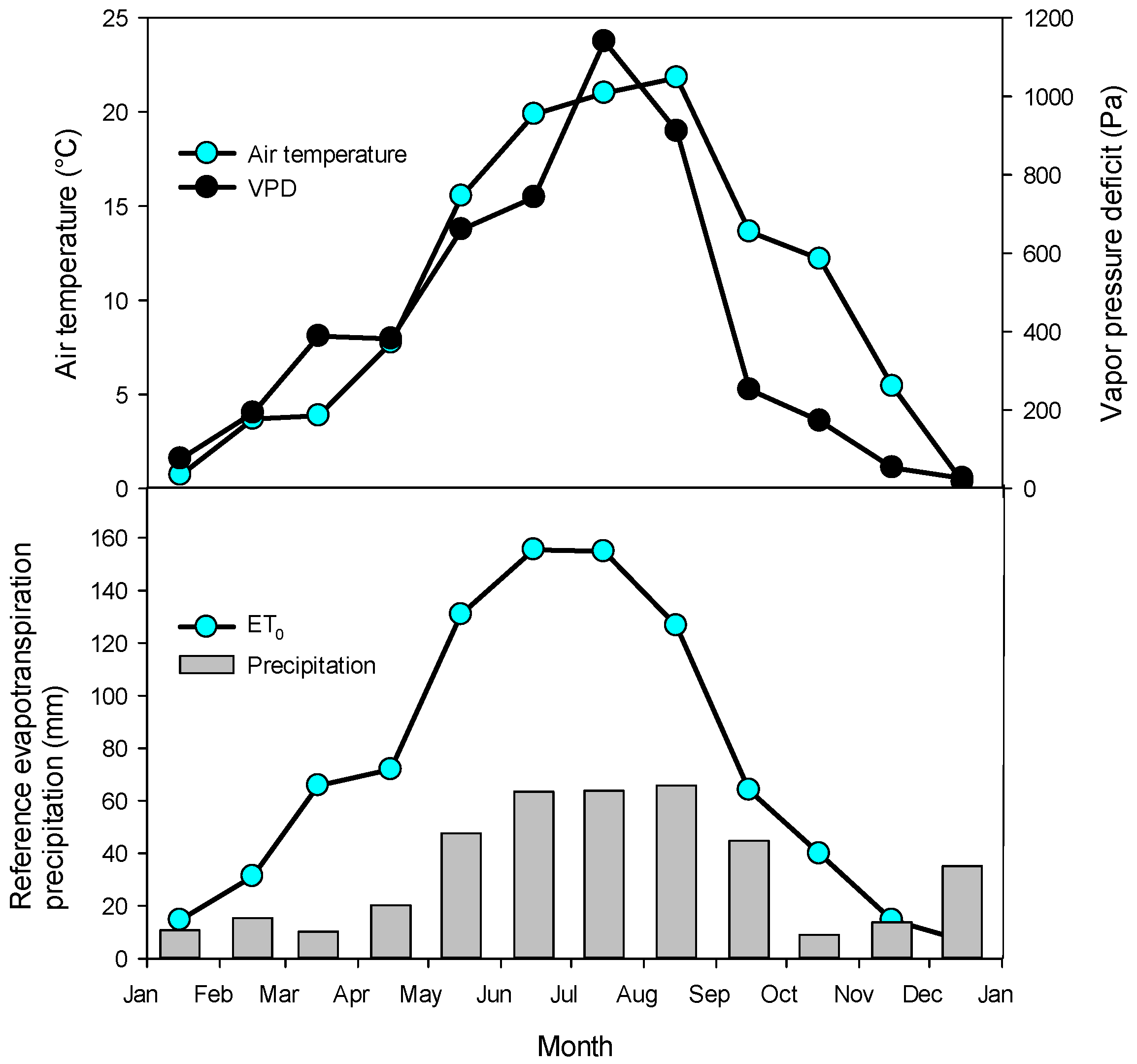
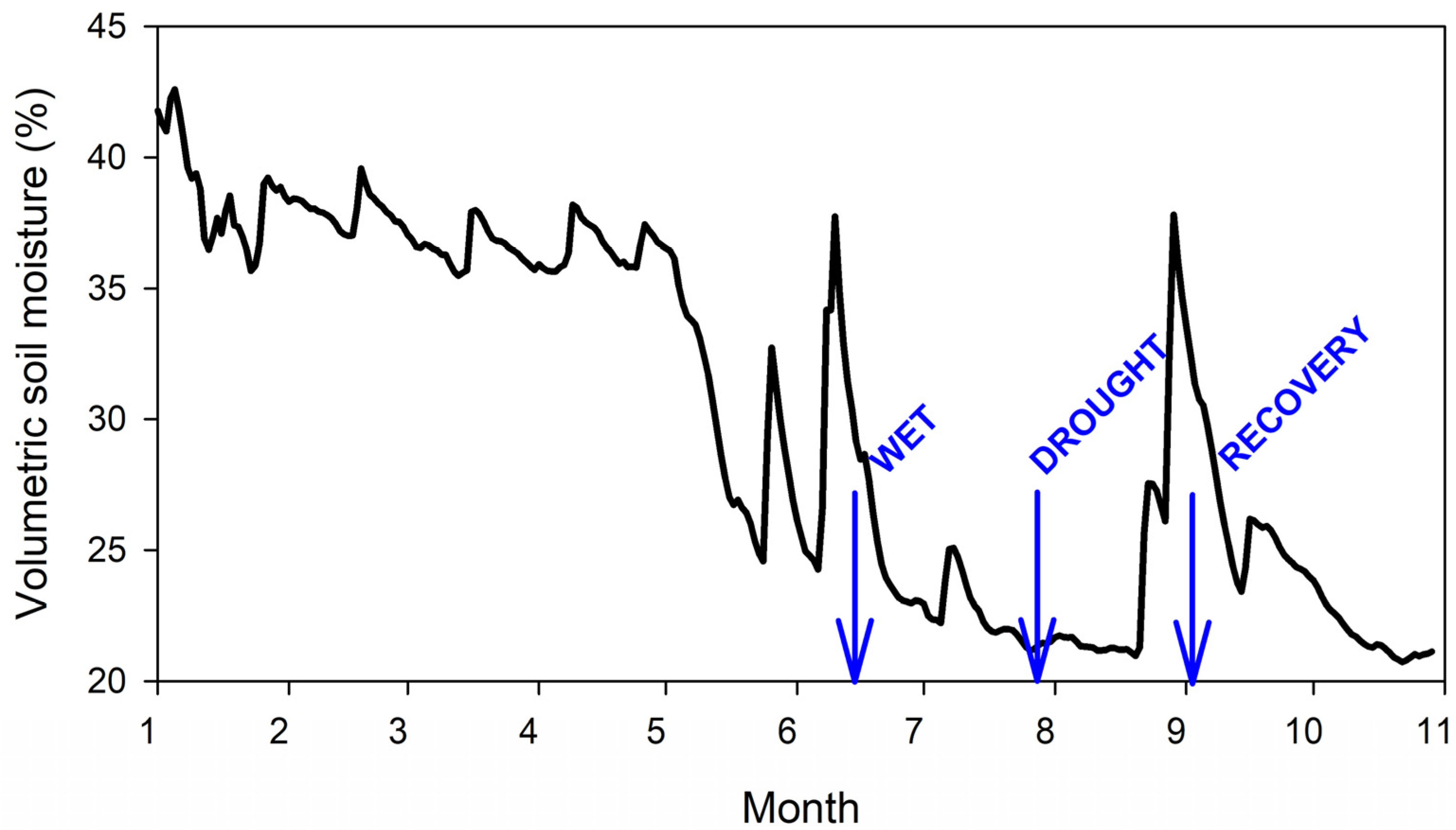

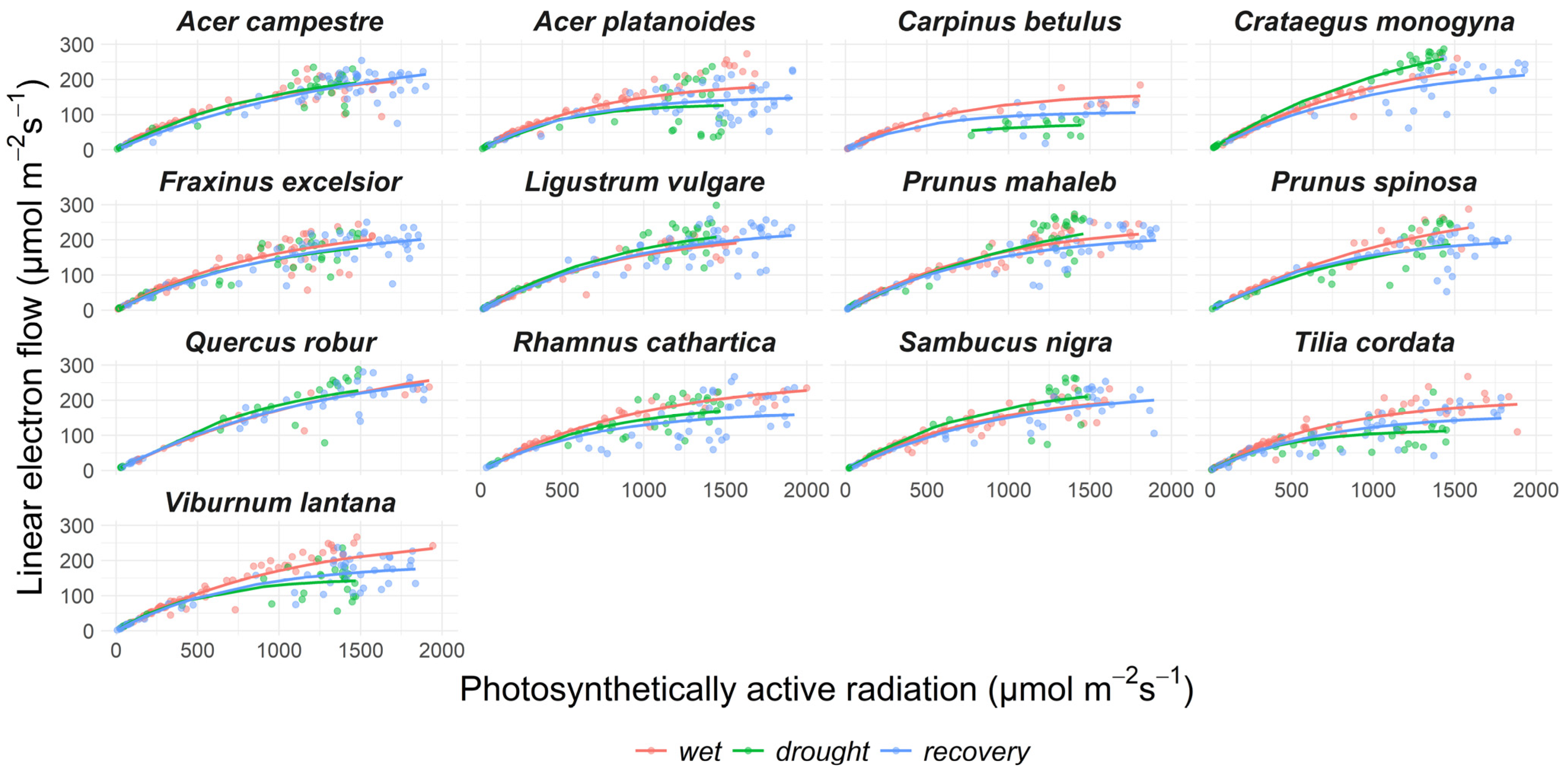
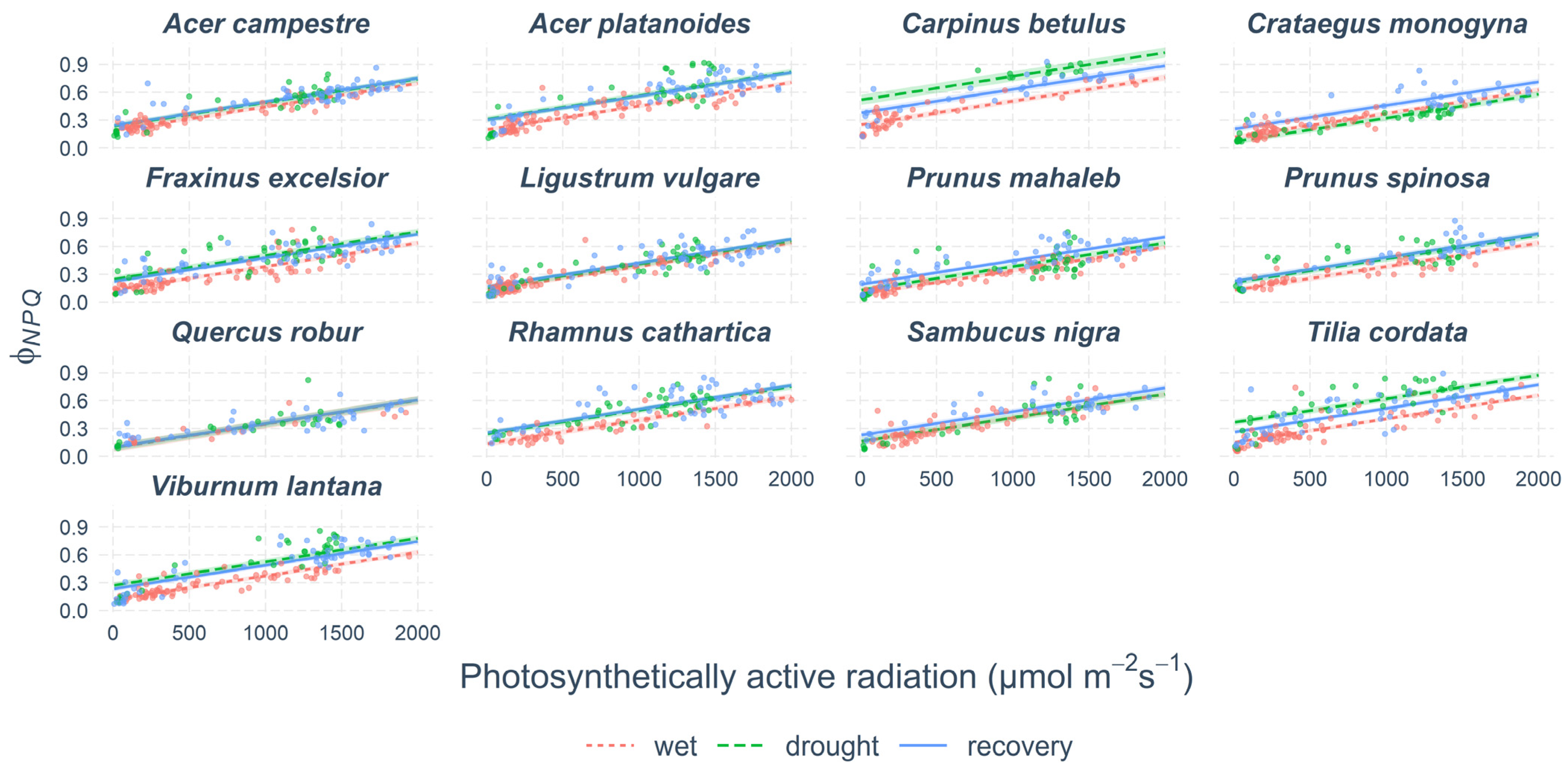
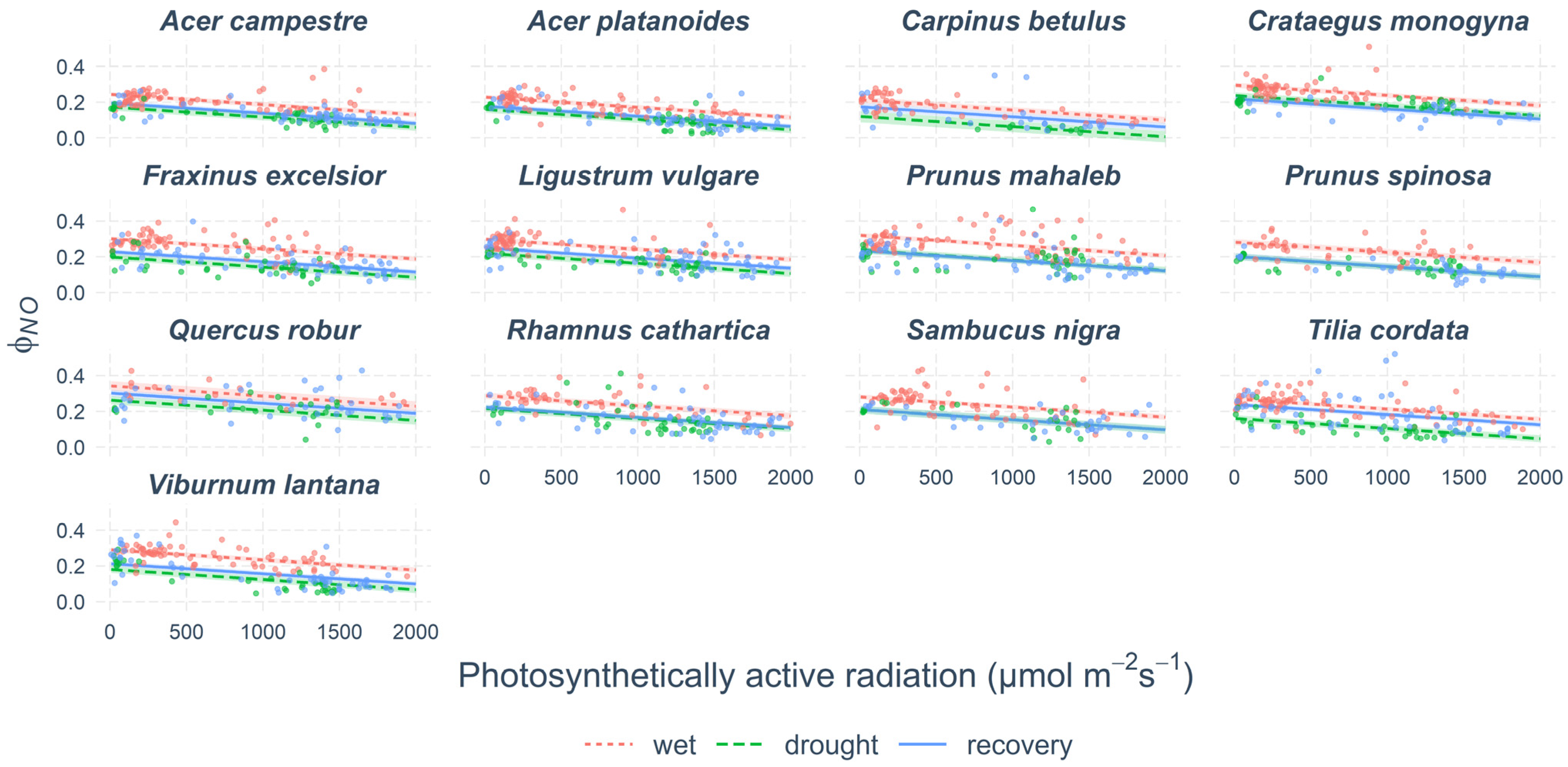
| Family | Character | Height (cm) | Breast Height Diameter (mm) | |||||
|---|---|---|---|---|---|---|---|---|
| Min | Max | Mean | Min | Max | Mean | |||
| Acer campestre | Sapindaceae | Tree | 80 | 1100 | 817 | 22 | 315 | 117 |
| Acer platanoides | Sapindaceae | Tree | 650 | 1500 | 1231 | 70 | 353 | 201 |
| Carpinus betulus | Betulaceae | Tree | 485 | 870 | 678 | 61 | 76 | 69 |
| Crataegus monogyna | Rosaceae | Shrub | 130 | 460 | 343 | |||
| Fraxinus excelsior | Oleaceae | Tree | 290 | 1600 | 1166 | 51 | 325 | 154 |
| Ligustrum vulgare | Oleaceae | Shrub | 50 | 324 | 173 | |||
| Prunus mahaleb | Rosaceae | Tree | 207 | 1950 | 767 | 16 | 95 | 49 |
| Prunus spinosa | Rosaceae | Shrub | 240 | 400 | 298 | |||
| Quercus robur | Fagaceae | Tree | 1200 | 1250 | 1225 | 500 | 660 | 580 |
| Rhamnus cathartica | Rhamnaceae | Shrub | 287 | 555 | 405 | |||
| Sambucus nigra | Viburnaceae | Shrub | 407 | 630 | 483 | |||
| Tilia cordata | Malvaceae | Tree | 185 | 1550 | 942 | 19 | 318 | 149 |
| Viburnum lantana | Viburnaceae | Shrub | 105 | 407 | 255 | |||
Disclaimer/Publisher’s Note: The statements, opinions and data contained in all publications are solely those of the individual author(s) and contributor(s) and not of MDPI and/or the editor(s). MDPI and/or the editor(s) disclaim responsibility for any injury to people or property resulting from any ideas, methods, instructions or products referred to in the content. |
© 2023 by the authors. Licensee MDPI, Basel, Switzerland. This article is an open access article distributed under the terms and conditions of the Creative Commons Attribution (CC BY) license (https://creativecommons.org/licenses/by/4.0/).
Share and Cite
Urban, J.; Matoušková, M.; Robb, W.; Jelínek, B.; Úradníček, L. Effect of Drought on Photosynthesis of Trees and Shrubs in Habitat Corridors. Forests 2023, 14, 1521. https://doi.org/10.3390/f14081521
Urban J, Matoušková M, Robb W, Jelínek B, Úradníček L. Effect of Drought on Photosynthesis of Trees and Shrubs in Habitat Corridors. Forests. 2023; 14(8):1521. https://doi.org/10.3390/f14081521
Chicago/Turabian StyleUrban, Josef, Marie Matoušková, William Robb, Boleslav Jelínek, and Luboš Úradníček. 2023. "Effect of Drought on Photosynthesis of Trees and Shrubs in Habitat Corridors" Forests 14, no. 8: 1521. https://doi.org/10.3390/f14081521





